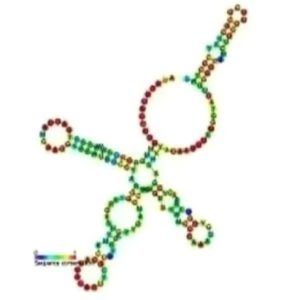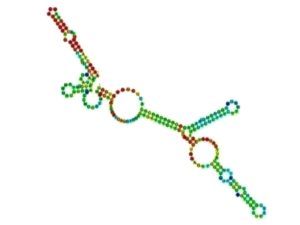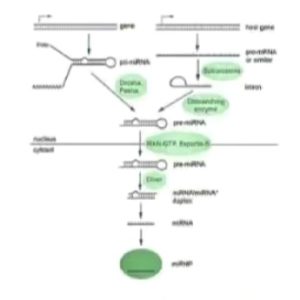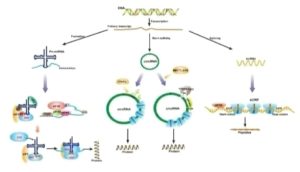- Messenger RNA (mRNA)
- Ribosomal RNA (rRNA)
- Transfer RNA (tRNA)
- Small Nuclear RNA (snRNA)
- Small Nucleolar RNA (snoRNA)
- MicroRNA (miRNA)
- Small Interfering RNA (siRNA)
- Long Non-Coding RNA (lncRNA)
- Piwi-Interacting RNA (piRNA)
- CRISPR-Associated RNA (crRNA)
- Small Regulatory RNA (sRNA)
- Enhancer RNA (erna)
- Repeat-Associated siRNA (rasiRNA)
- Telomerase RNA (TER or TERRA)
- Circular RNA (circRNA)
- Y RNA
1 Messenger RNA (mRNA)

mRNA is a single-stranded RNA molecule that acts as an intermediary in transferring genetic information from DNA to protein synthesis. Through transcription and RNA splicing, mRNA carries coding information from genes to the ribosome, where it is translated into a specific sequence of amino acids.
Structure:
Composed of nucleotides, each consisting of a phosphate group, a ribose, and a nitrogenous base (adenine (A), guanine (G), cytosine (C), and uracil (U)). Uracil replaces thymine (T) found in DNA.
Function:
Acts as a template or messenger in the process of protein synthesis, transferring genetic information from DNA in the cell nucleus to the ribosome where proteins are synthesized. This transfer of genetic information is called transcription and is a key step in the central dogma of molecular biology.
2 Ribosomal RNA (rRNA)

rRNA is a non-coding RNA that plays a crucial role in protein synthesis. It constitutes the main component of the ribosome, which is responsible for translating genetic information into proteins.
Structure:
Divided into two main types, the large subunit (LSU) and the small subunit (SSU).
In prokaryotes such as bacteria, the LSU is composed of a single small rRNA molecule and a single large rRNA molecule along with ribosomal proteins. The SSU contains a small rRNA molecule.
In eukaryotes such as humans, the LSU is composed of two small rRNA molecules and a large rRNA molecule along with over 70 types of ribosomal proteins. The SSU contains a small rRNA molecule.
Function:
Biogenesis of ribosomes: The synthesis of rRNA and its subsequent assembly with ribosomal proteins is an important step in ribosome biogenesis.
Formation of ribosomal subunits: Both prokaryotic and eukaryotic ribosomes are composed of two subunits, a larger subunit and a smaller subunit. During the translation of mRNA, these subunits come together to form a functional ribosome.
Localization of ribosomes: Ribosomes can either be associated with the endoplasmic reticulum (ER) or exist as free-floating particles in the cytoplasm. Free ribosomes synthesize proteins that function within the cytoplasm.
3 Transfer RNA (tRNA)

tRNA is a key molecule involved in protein synthesis, acting as an adapter between mRNA and the amino acid sequence of proteins.
Structure:
Primary structure consists of a 5′ end, 3′ end, D-loop, and TC-loop. Secondary structure is formed by base-paired D-arm, T-arm, double arm, and tip arm. Tertiary structure is driven by non-covalent interactions forming L-shaped and D-shaped regions.
Function:
Amino acid carrier: The main function of tRNA is to transport amino acids to the ribosome during protein synthesis.
Recognition of mRNA codons: tRNA has an anticodon sequence that is complementary to the codon sequence on mRNA.
Amino acid translocation: tRNA is involved in the translocation process during protein synthesis.
Ribosome binding: tRNA molecules interact with the ribosome, the cellular machinery responsible for protein synthesis.
Translational tuning: Some tRNA molecules contain modified nucleotides, which affect the stability of tRNA structure, its interaction with the ribosome, and the accuracy of decoding during translation.
4 Small Nuclear RNA (snRNA)

snRNA is a class of RNA molecules with multiple functions within the cell nucleus. snRNA plays a significant role in pre-mRNA processing, transcription regulation, telomere maintenance, and association with special nuclear structures.
Structure:
Length and transcription: snRNA molecules are about 150 nucleotides long and are transcribed by RNA polymerase II or RNA polymerase III.
Association with proteins: snRNA is always associated with specific proteins, forming a complex called snRNP. These complexes consist of snRNA and snRNP-specific proteins, such as Sm proteins. Common snRNAs in human cells include U1, U2, U4, U5, and U6 spliceosomal RNAs.
Function:
Pre-mRNA processing: Involved in the splicing of introns and the formation of mature mRNA.
Transcriptional regulation: Regulates the activity of transcription factors or RNA polymerase II.
Telomere maintenance: Participates in the complex mechanisms that maintain the appropriate length and function of telomeres.
5 Small Nucleolar RNA (snoRNA)

snoRNA is a group of small RNA molecules found in the nucleolus. They perform various important functions within the cell.
Structure:
snoRNA is rich in adenosine (A) and thymidine (T), and has specific structural elements, divided into three major classes: box C/D snoRNA, box H/ACA snoRNA, and MRP RNA.
Function:
Involved in ribosome synthesis.
Chemical modification of specific nucleotides in various RNA molecules.
Participation in pre-mRNA splicing.
Some types of snoRNA can act as templates for telomere synthesis.
6 MicroRNA (miRNA)

miRNA is a class of single-stranded RNA fragments 21-25 nucleotides in length and are widely present post-transcriptional regulatory factors in eukaryotes.
Structure:
Single-stranded structure.
Function:
Interacts with mRNA molecules to regulate gene expression, controlling their translation. Involved in regulating a variety of cellular activities, including cell growth, differentiation, apoptosis, etc., and is associated with various diseases.
7 Small Interfering RNA (siRNA)

Small interfering RNA, sometimes called short interfering RNA or silencer RNA, is a double-stranded RNA 20-25 nucleotides in length.
Structure:
Double-stranded structure.
Function:
Inhibition of protein synthesis: When siRNA enters a cell, it can bind to target mRNA, leading to the cleavage of mRNA into shorter fragments, thereby preventing the production of the corresponding protein.
Gene silencing: Combines with the RNA-induced silencing complex (RISC), which cleaves mRNA that matches it, leading to a decrease or cessation of gene expression.
8 Long Non-Coding RNA (lncRNA)

Long non-coding RNA represents a diverse array of important regulatory molecules that contribute to gene regulation and various cellular processes. They exhibit unique features, including tissue specificity and developmental stage specificity.
Structure:
A non-coding RNA longer than 200 nucleotides.
Linear structure: A linear structure composed of a series of nucleotides that can be adenine (A), cytosine (C), guanine (G), or uracil (U) in RNA, and thymine (T) in DNA.
Secondary structure: Stem-loops, hairpins, bulges, internal loops, and pseudoknots.
Higher-order structure: lncRNA folds into higher-order structures usually mediated by interactions between different regions of the molecule, including base pairing, stacking interactions, and tertiary interactions.
Domains and motifs: lncRNA can contain specific structural domains or motifs in their sequences, responsible for their functional interactions.
Chromatin structure: lncRNA can interact with chromatin and form complexes with chromatin-modifying proteins, thereby aiding in the regulation of gene expression.
Function:
lncRNA has multiple functions in gene expression regulation. They can act at multiple levels, including transcriptional regulation, post-transcriptional regulation, and epigenetic regulation.
9 Piwi-Interacting RNA (piRNA)
PiRNA is a class of shorter non-coding RNAs, typically 24-32 nucleotides in length, mainly found in germ cells and interact with piwi proteins.
Function:
Involved in the regulation of transposon (mobile genetic elements) activity, maintaining genomic stability, and the development of germ cells.
10 CRISPR-Associated RNA (crRNA)
crRNA is a type of RNA found in bacteria and archaea, associated with the CRISPR-Cas system.
Function:
Participates in immune responses with Cas proteins to identify and cleave invading viruses or foreign DNA.
11 Small Regulatory RNA (sRNA)
sRNA is a class of shorter non-coding RNA molecules, typically 50-250 nucleotides.
Function:
Involved in gene expression regulation, post-transcriptional modification, transposon suppression, and other processes.
12 Enhancer RNA (erna)
ERNA is a short RNA molecule produced in the enhancer region.
Function:
Participates in the regulation of target gene expression, promotes chromatin remodeling, and gene transcription.
13 Repeat-Associated siRNA (rasiRNA)
RasiRNA is a class of small interfering RNAs associated with repetitive sequences.
Function:
Involved in the maintenance and regulation of genomic stability, suppressing the expression of repetitive sequences through the RNA interference pathway.
14 Telomerase RNA (TER or TERRA)
Telomerase RNA is an RNA molecule involved in telomere elongation.
Function:
Participates in telomere replication and maintenance, helping to maintain chromosomal stability and prevent telomere shortening.
15 Circular RNA (circRNA)
CircRNA is a class of RNA molecules that form closed-loop structures with high stability. They form closed-loop structures through specific splicing reactions and lack 5′ and 3′ ends.
Function:
Regulates gene expression, fine-tunes transcription, and affects RNA metabolism.
16 Y RNA
YRNA is a class of small non-coding RNAs initially discovered in the nucleolus.
Function:
Involved in the stability and metabolic regulation of cellular RNA, associated with RNA processing, transport, and translation processes.
Please note that this translation is meant to be used for educational and informative purposes. For a publication, it’s advised to have it reviewed by a professional in the field to ensure accuracy and adherence to specific terminology used in scientific literature.

